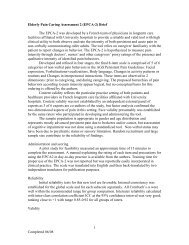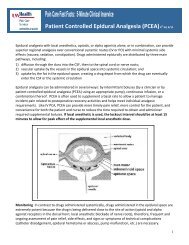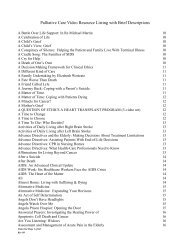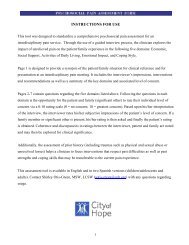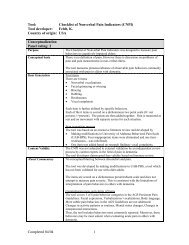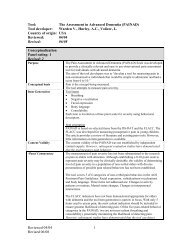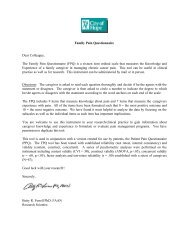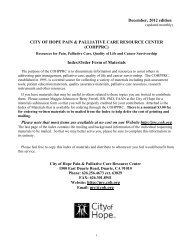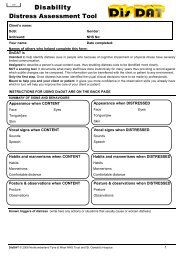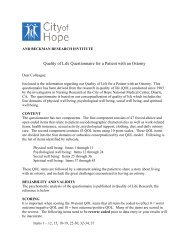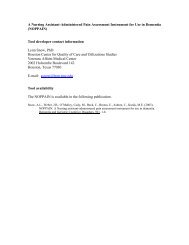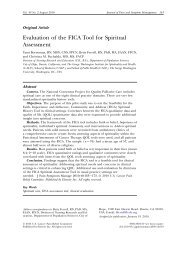The palliative care quiz for nursing (PCQN): the development of an ...
The palliative care quiz for nursing (PCQN): the development of an ...
The palliative care quiz for nursing (PCQN): the development of an ...
Create successful ePaper yourself
Turn your PDF publications into a flip-book with our unique Google optimized e-Paper software.
M M Ross et alby providmg data about <strong>the</strong> level <strong>of</strong> knowledge alreadypossessed by potential particip<strong>an</strong>ts <strong>an</strong>d allow educators t<strong>of</strong>ocus instruction on <strong>the</strong> issues <strong>of</strong> greatest needThis finding also suggests that educational programmesin <strong>palliative</strong> <strong>care</strong> should be targeted <strong>for</strong> specific audienceswith specific leammg needs Never<strong>the</strong>less, given <strong>the</strong> simil<strong>an</strong>tiesm misconceptions across groups, <strong>the</strong>re is a need<strong>for</strong> all levels <strong>of</strong> nurses to upgrade <strong>the</strong>ir level <strong>of</strong> knowledge<strong>of</strong> <strong>the</strong> concepts <strong>of</strong> <strong>palliative</strong> <strong>care</strong> <strong>an</strong>d <strong>the</strong>ir application mclmical practice <strong>The</strong> <strong>PCQN</strong> c<strong>an</strong> be useful m identifying<strong>an</strong>d correcting <strong>the</strong>ir misconceptions about <strong>palliative</strong> <strong>care</strong>nursmgFinally, <strong>the</strong> <strong>quiz</strong> c<strong>an</strong> also be used as a tool <strong>for</strong> instructionitself or as <strong>the</strong> primary focus <strong>for</strong> a period <strong>of</strong> instructionwithout <strong>an</strong>y pre- or post-testing In this way, <strong>the</strong> <strong>PCQN</strong>c<strong>an</strong> be used to encourage students to be active particip<strong>an</strong>tsm <strong>the</strong>ir learning by stimulating discussion <strong>of</strong> issues relatedto <strong>palliative</strong> <strong>care</strong> nursmgLimitationsDespite Its potential use, <strong>the</strong> <strong>PCQN</strong> has several limitationsIt IS not designed to provide a comprehensive assessment<strong>of</strong> knowledge <strong>of</strong> <strong>palliative</strong> <strong>care</strong> or <strong>palliative</strong> <strong>care</strong> <strong>nursing</strong>Brevify <strong>an</strong>d simplicify <strong>of</strong> administration <strong>an</strong>d scoringmakes <strong>the</strong> <strong>quiz</strong> useful <strong>for</strong> m<strong>an</strong>y educators but limits itsvalue vnth respect to <strong>the</strong> comprehensive assessment <strong>of</strong>higher levels <strong>of</strong> knowledge associated with expertise in<strong>palliative</strong> <strong>care</strong> practice <strong>The</strong>re<strong>for</strong>e, it is not appropriate <strong>for</strong><strong>the</strong> assessment <strong>of</strong> knowledge levels <strong>of</strong> expert practitionersRa<strong>the</strong>r, <strong>the</strong> <strong>quiz</strong> focuses on <strong>the</strong> basic type <strong>of</strong> in<strong>for</strong>mationrequired <strong>for</strong> entry to practice that would normally be foundm introductory courses, workshops <strong>an</strong>d programmes<strong>The</strong> predictive validify <strong>of</strong> <strong>the</strong> <strong>quiz</strong> has not been assessed<strong>an</strong>d <strong>the</strong>re<strong>for</strong>e it is not known to what degree knowledgeas measured hy <strong>the</strong> <strong>PCQN</strong> is related to actual behaviourFur<strong>the</strong>r research should examine this issue as well as <strong>the</strong>issue <strong>of</strong> whe<strong>the</strong>r <strong>the</strong> <strong>quiz</strong> is useful <strong>for</strong> assessing ch<strong>an</strong>ge inknowledge resulting from instruction In addition, <strong>the</strong>sample with whom <strong>the</strong> <strong>quiz</strong> was developed was not fullyrepresentative <strong>of</strong> <strong>the</strong> broad r<strong>an</strong>ge <strong>of</strong> nursmg personnel withwhom <strong>the</strong> qmz might eventually be used Pilot testing witha more representative sample <strong>of</strong> registered nurses,registered practical nurses <strong>an</strong>d o<strong>the</strong>r categones <strong>of</strong> nursmgpersonnel, would be wise to assure that <strong>the</strong> reading levels<strong>an</strong>d content associated with <strong>the</strong> <strong>PCQN</strong> are appropnateAlthough <strong>the</strong> psychometnc properties <strong>of</strong> <strong>the</strong> <strong>PCQN</strong>could be improved by elimmating some <strong>of</strong> <strong>the</strong> items,especially those with <strong>an</strong> item difficulfy <strong>of</strong> over 0 80 <strong>for</strong>registered nurses, a decision was made to retain <strong>the</strong>seItems m order to add to <strong>the</strong> edumetnc properties <strong>of</strong> <strong>the</strong><strong>quiz</strong> <strong>The</strong> <strong>quiz</strong> is designed to yield measurements that aredirectly interpretable m terms <strong>of</strong> specific per<strong>for</strong>m<strong>an</strong>cest<strong>an</strong>dards (Glaser & Mitko 1971) <strong>The</strong> specified per<strong>for</strong>m<strong>an</strong>cest<strong>an</strong>dard m this case is <strong>the</strong> abilify to <strong>an</strong>swer all 20items correctly Given this st<strong>an</strong>dard, it is not crucial thatall Items have a high discnmmatory power or high itemto total correlation An mdividual who c<strong>an</strong> <strong>an</strong>swer <strong>the</strong>item correctly has more in<strong>for</strong>mation th<strong>an</strong> <strong>an</strong> mdividualwho c<strong>an</strong>notO<strong>the</strong>r edumetnc properties include <strong>the</strong> abilify to identifymisconceptions <strong>an</strong>d to stimulate discussion about <strong>palliative</strong><strong>care</strong> nursmg <strong>The</strong>se properties would not have beenimproved by attending too stnngently to <strong>the</strong> entena <strong>of</strong>item difficulty <strong>an</strong>d item discrimination Such entena,while eentral to <strong>the</strong> psyehometnc properties <strong>of</strong> a test, arenot necess<strong>an</strong>ly central to its edumetnc properties Thus,by retaining items that have not attained optimal psychometncproperties <strong>for</strong> one group <strong>of</strong> respondents, but thatare conceptually import<strong>an</strong>t, it is expected that <strong>the</strong> edumetncproperties <strong>of</strong> <strong>the</strong> <strong>quiz</strong> are enh<strong>an</strong>cedConclusionIn conclusion, <strong>the</strong> <strong>palliative</strong> <strong>care</strong> <strong>quiz</strong> <strong>for</strong> nursmg appearsto be a promising tool with utility <strong>for</strong> assessing knowledge,stimulating discussion <strong>an</strong>d identifying misconceptions<strong>The</strong> <strong>quiz</strong> c<strong>an</strong> be used <strong>for</strong> assessing learning needs <strong>an</strong>d maybe useful as a teachmg tool <strong>an</strong>d <strong>for</strong> contnbutmg to <strong>the</strong>evaluation <strong>of</strong> educational programmes related to <strong>the</strong> provision<strong>of</strong> <strong>palliative</strong> <strong>care</strong> <strong>The</strong> <strong>development</strong> <strong>of</strong> <strong>the</strong> <strong>palliative</strong><strong>care</strong> <strong>quiz</strong> <strong>for</strong> nursmg helps to fill <strong>the</strong> gap m instrumentationavailable <strong>for</strong> teaching <strong>an</strong>d research initiatives aimedat improving <strong>the</strong> qualify <strong>of</strong> education received by health<strong>care</strong> providers <strong>an</strong>d ultimately <strong>the</strong> qualify <strong>of</strong> <strong>palliative</strong> <strong>care</strong>received by those who are dying <strong>an</strong>d <strong>the</strong>ir familiesAcknowledgements<strong>The</strong> Ottawa Carleton Regional Palliative Care Associationprovided <strong>the</strong> major funding <strong>for</strong> this project KnollPharmaceutics, <strong>the</strong> Victon<strong>an</strong> Order <strong>of</strong> Nurses (OttawaCarleton Br<strong>an</strong>ch), <strong>the</strong> Ottawa Carleton Regional C<strong>an</strong>cerCentre <strong>an</strong>d <strong>the</strong> Riverside Hospitid provided additionalfundmg A Community Researcher Award from <strong>the</strong>National Health <strong>an</strong>d Research Development Programme<strong>an</strong>d a Mimstry <strong>of</strong> Health <strong>of</strong> Ont<strong>an</strong>o Career Scientist Awardto Dr Margaret M Ross also provided assist<strong>an</strong>ce with<strong>the</strong> conduct <strong>of</strong> <strong>the</strong> study <strong>an</strong>d <strong>the</strong> preparation <strong>of</strong> thism<strong>an</strong>uscriptReferencesBenner P (1984) From Novice to Expert Excellence <strong>an</strong>d Powerin Clinical Nursing Practice Addison-Wesley, Menlo Park,Gali<strong>for</strong>maBenoliel J Q (1985) Loss <strong>an</strong>d terminal illness Nursing Climes <strong>of</strong>North Amenca 20(2), 439-448Gourtenay B G & Weidem<strong>an</strong> G (1985) <strong>The</strong> effects <strong>of</strong> a 'don't know'134 © 1996 BlackweU Science Ltd, Journal <strong>of</strong> Adv<strong>an</strong>ced Nursmg, 23, 126—137




